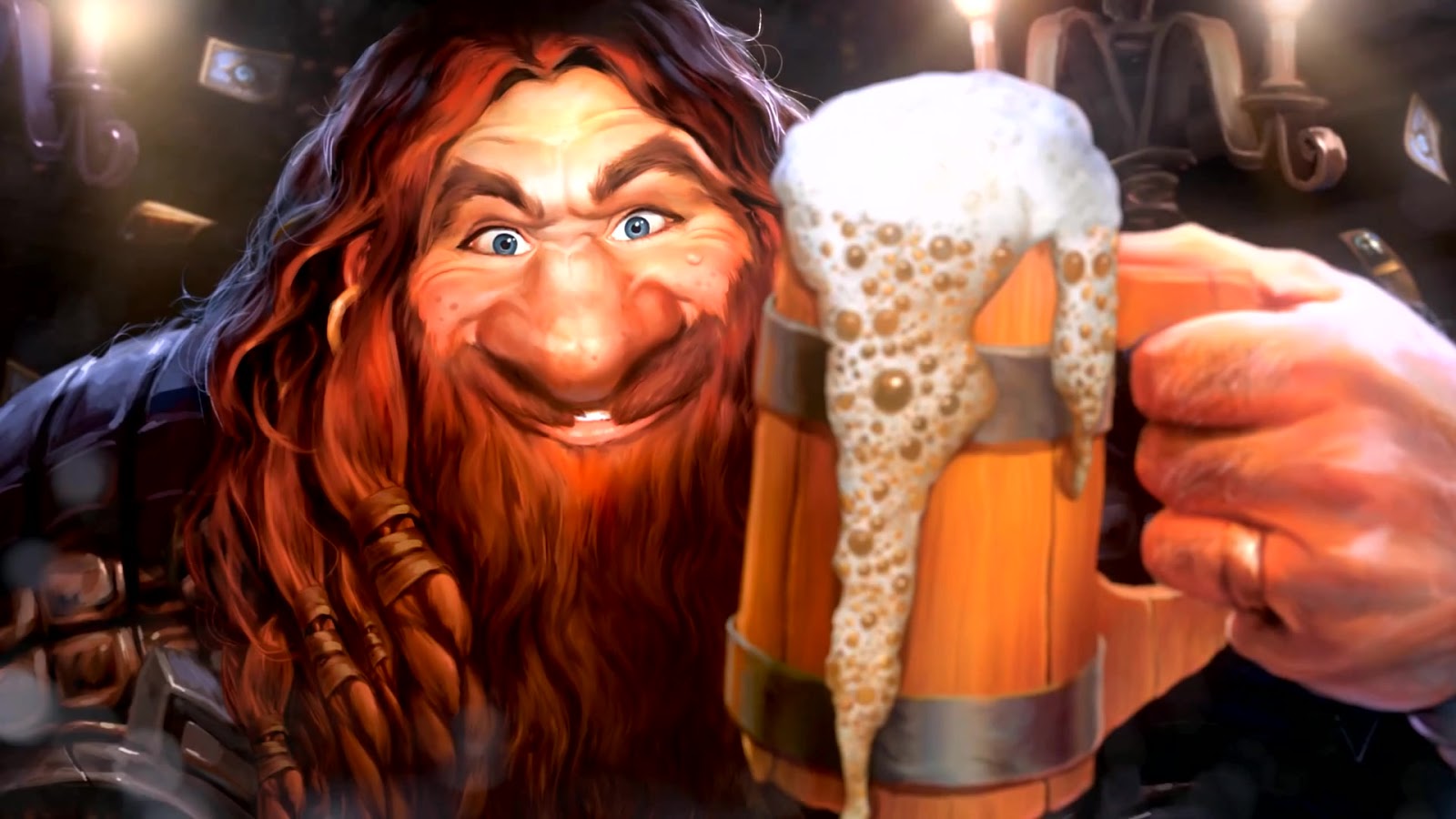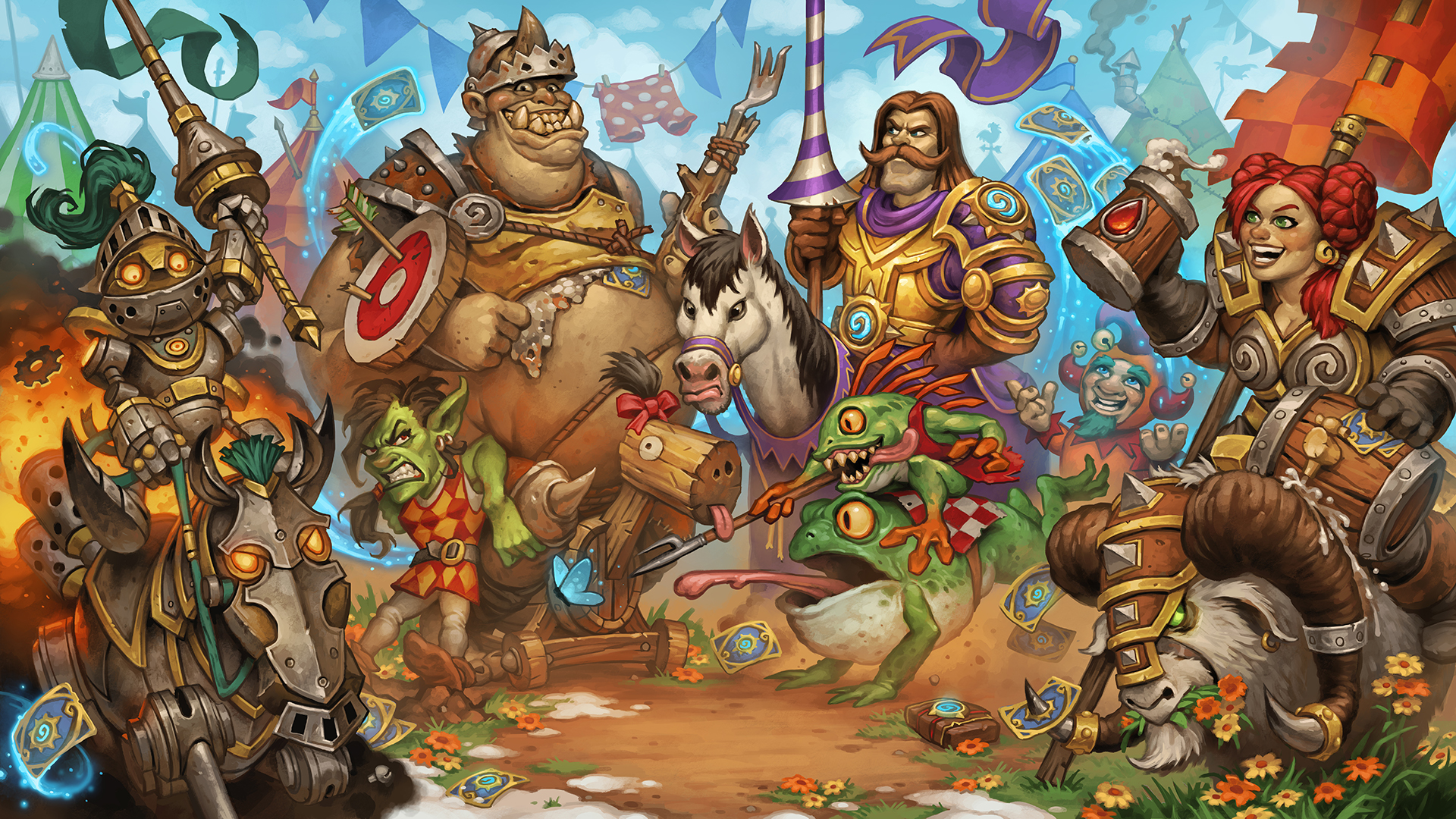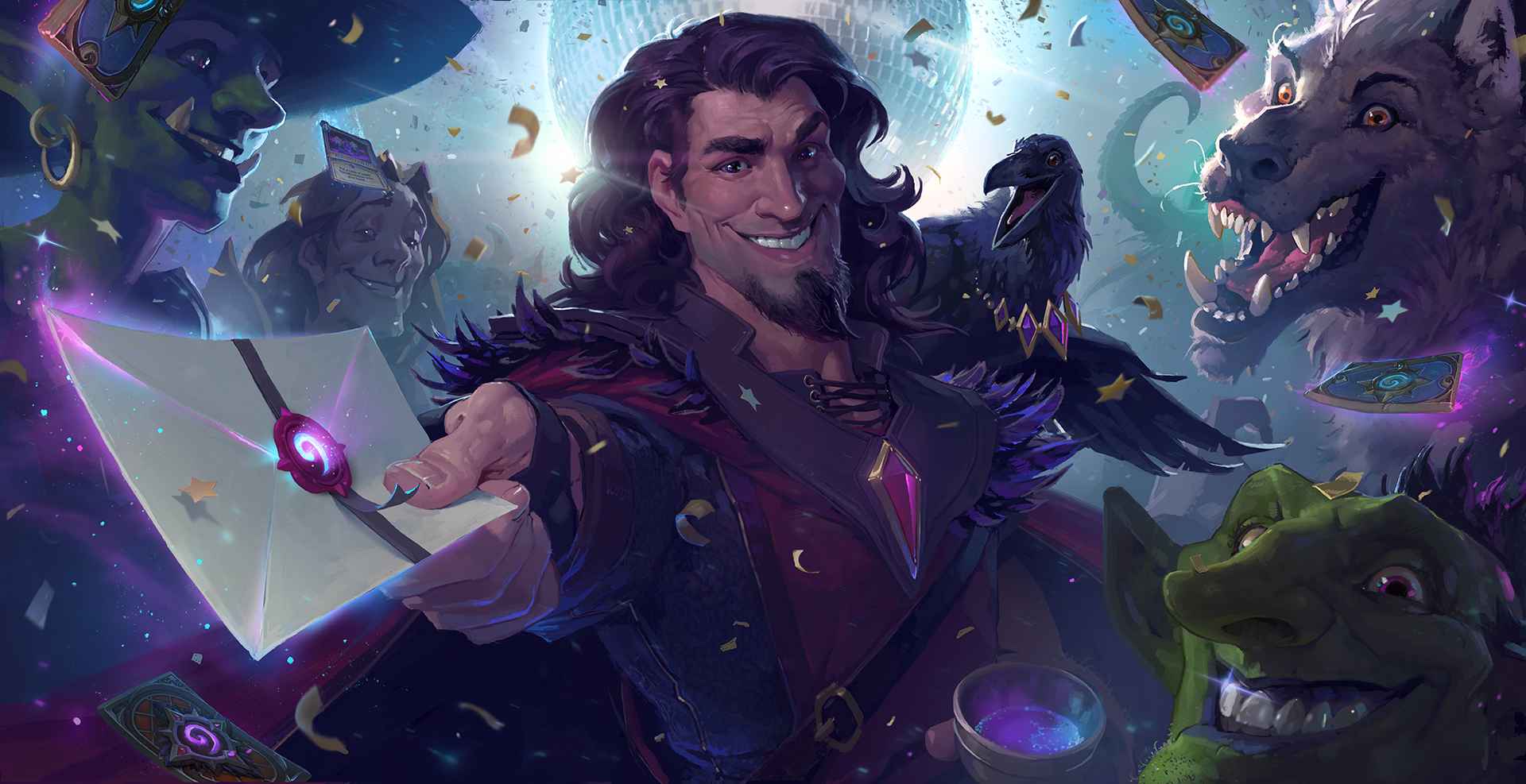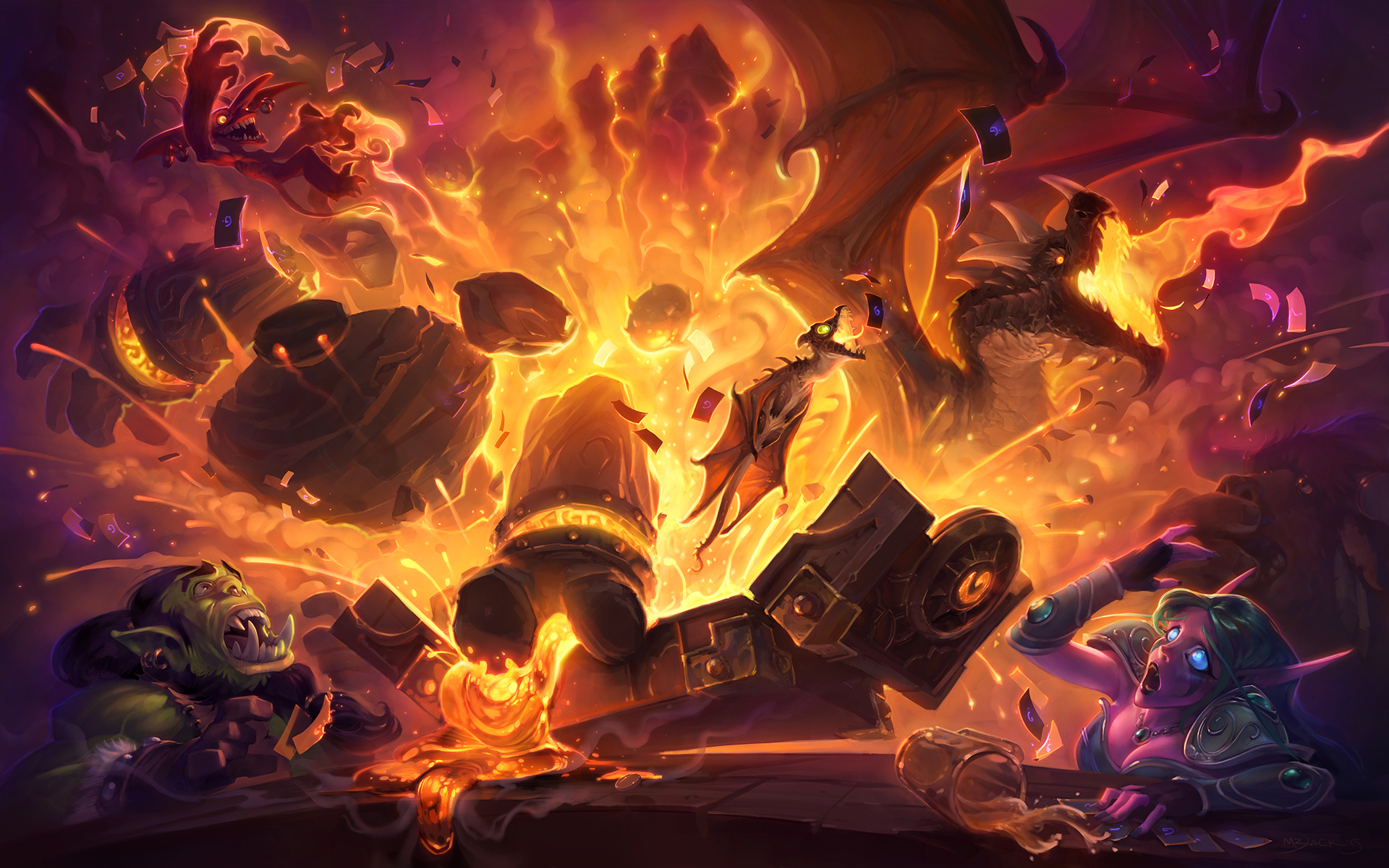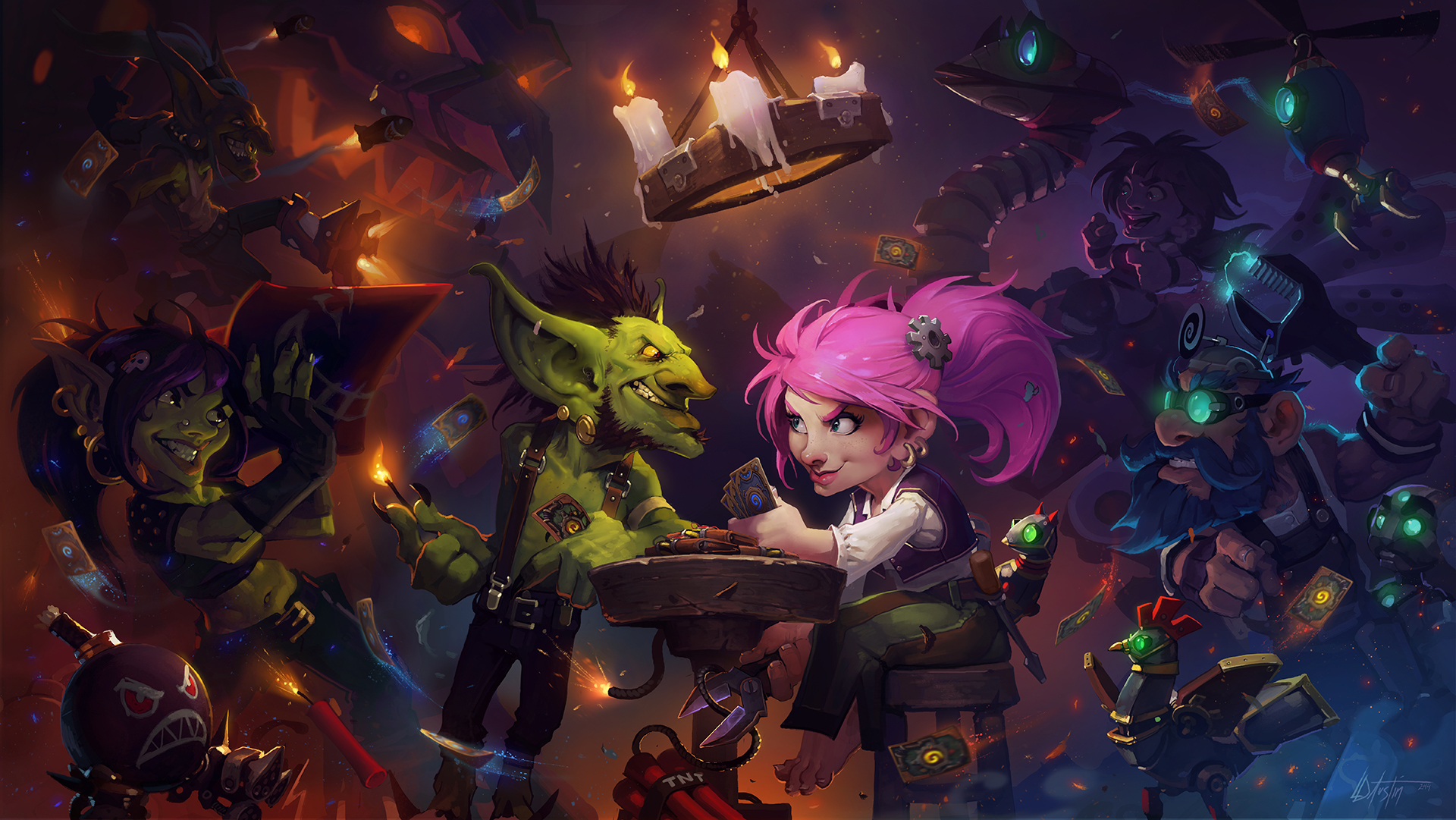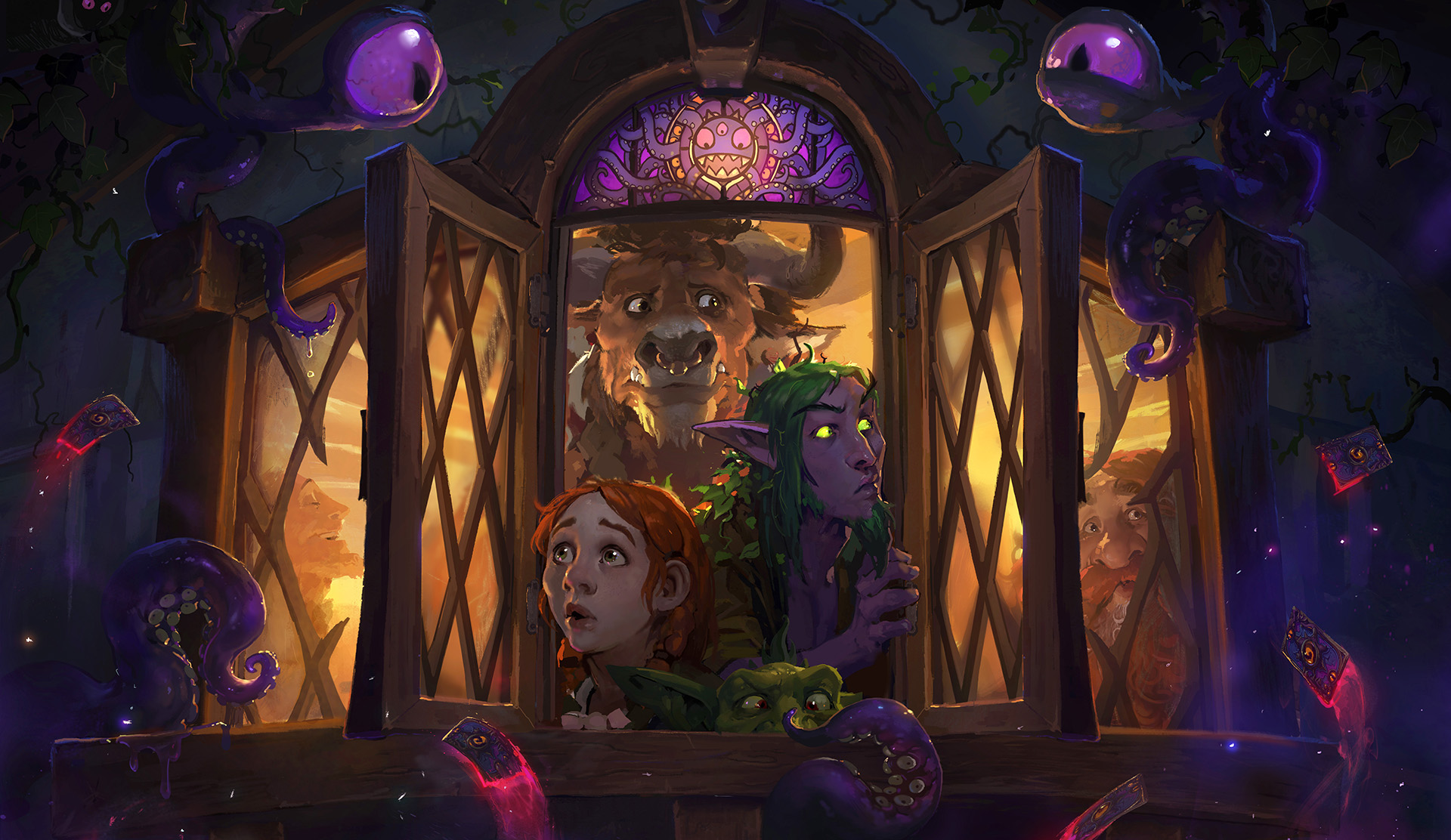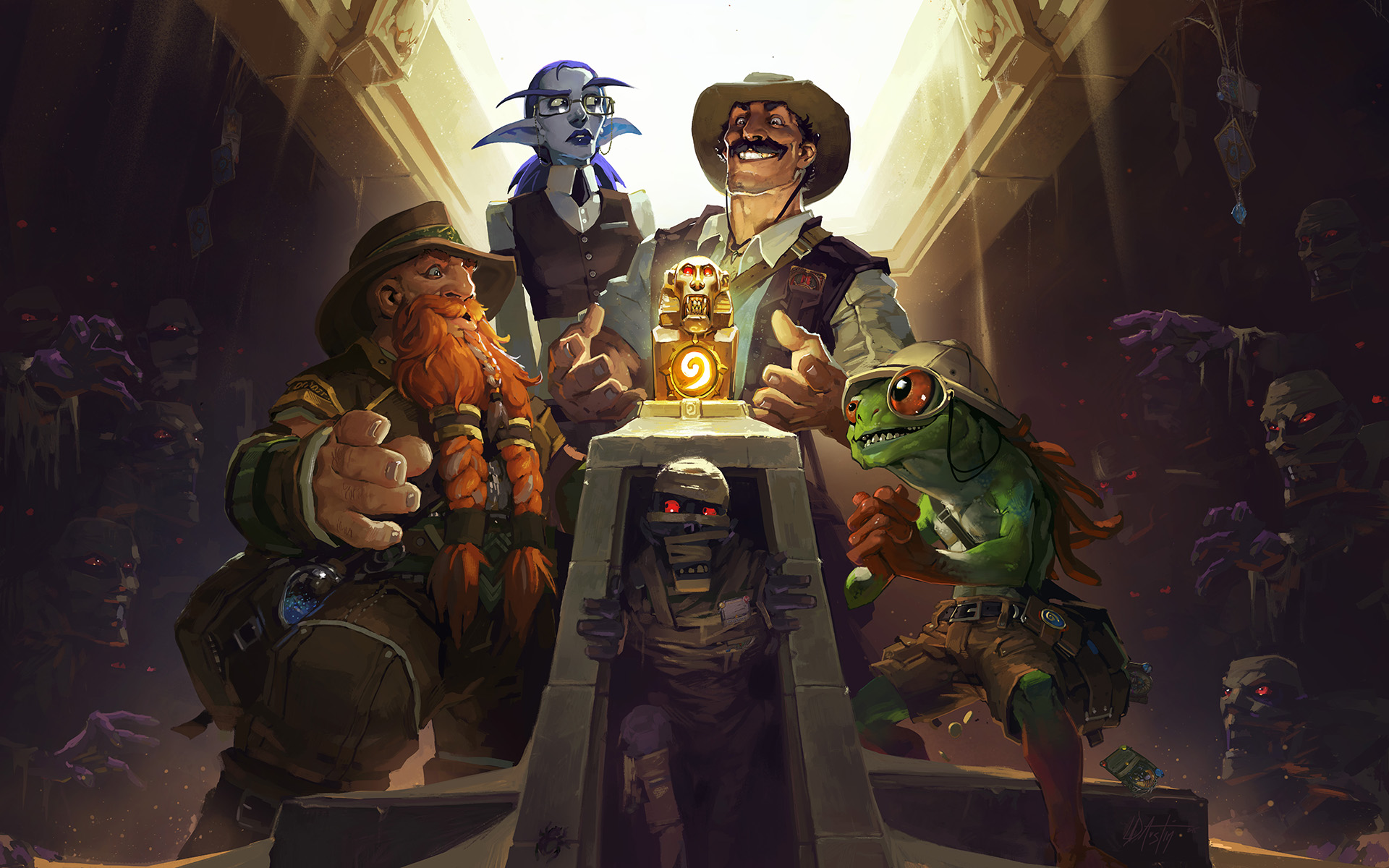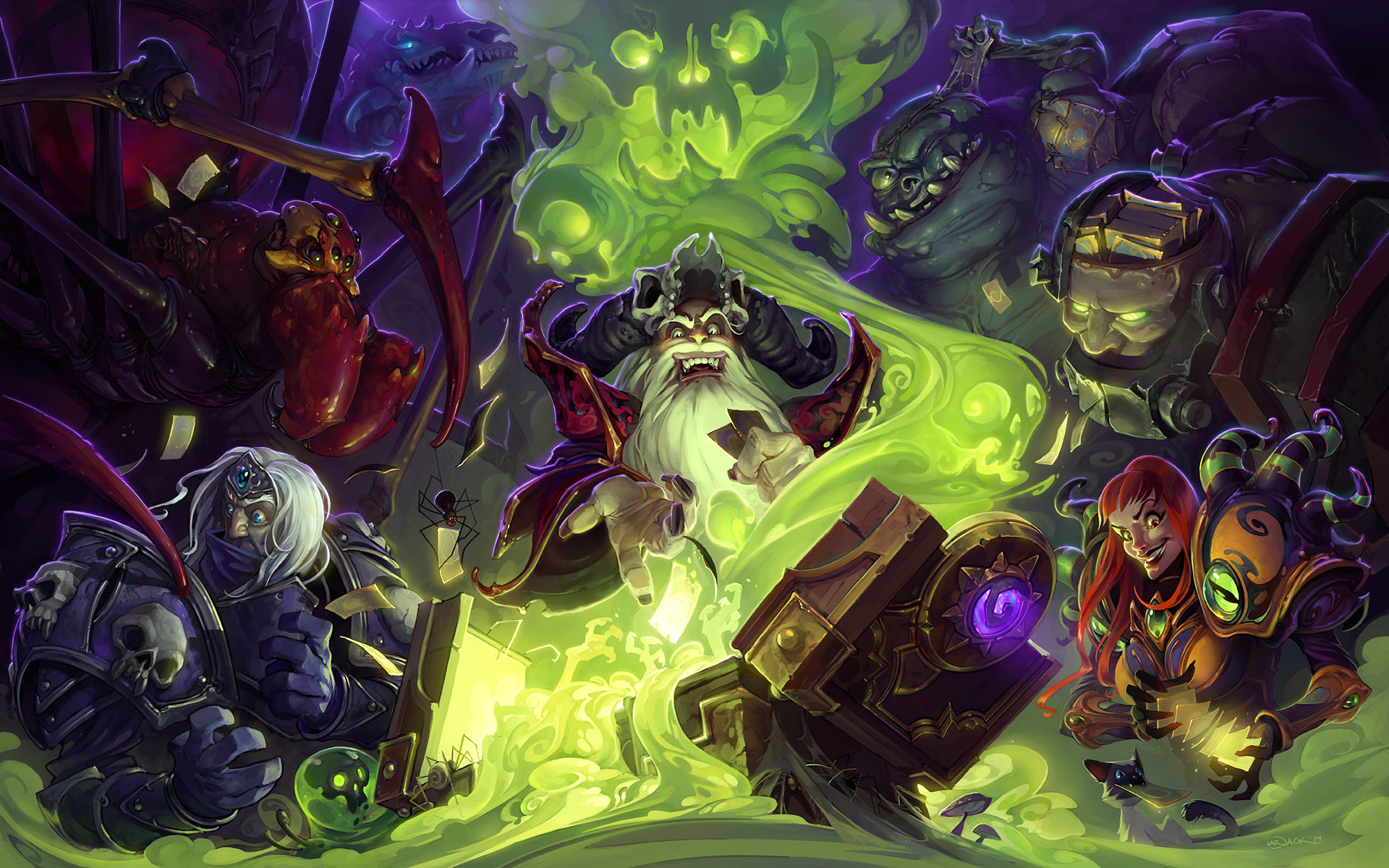Which Hearthstone expansion is best? This month we’re playing a risky hand by giving our verdicts on some of PC gaming’s most beloved series, including Dark Souls and Mass Effect.
As anyone who’s played Hearthstone will already know, all cards are not created equal. For every imagination-grabbing legendary like Emperor Thaurissan, there are half a dozen Boogeymonsters clogging up your packs. As part of our month-long look back at some of the series which have defined PC gaming, I was asked to rank Hearthstone’s expansions so far. The obvious problem here is that there’s a big difference between the full sets, which contain over 100 cards, and the smaller adventures, which also feature PvE encounters.
So to make the comparison as fair as possible, I’ve focused on the overall quality and consistency of the cards in each set, the impact they had on the metagame, and how fun each expansion’s theme was. So you won’t find a lot of talk about individual bosses, but hopefully you will enjoy the trip down memory lane—even if things do get a little dark in the Undertaker Hunter era. It was a pleasure to write, and at all times I tried to keep in mind this quote from an old interview with game director Eric Dodds: “...if we’re making cards and some of them don’t scare us a little bit, we’re doing it wrong.”
The Grand Tournament
Game of moans
Released: August 2015
Time may judge The Grand Tournament more kindly, but for now it stands as Hearthstone’s least loved set. There’s a temptation to view TGT as a wholesale failure because it didn’t lead to any competitive decks built purely around the Inspire keyword. But in TGT’s defence, it was also the set that finally made Dragons viable and gave Shaman some of the tools that would eventually see it become the terror it is today.
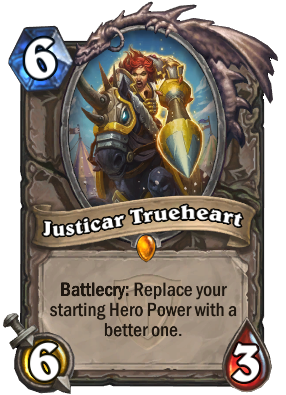
She might as well be a Warrior class card at this point, because being able to “tank up” for 4 armor every turn is absolutely core to the control deck’s gameplan. But Justicar has also seen play in Priest and Paladin, and the fact her ability effects each class differently makes her one of the most interestingly designed legendaries in the game.
Looking back, it’s also notable that when Inspire cards are good—as Murloc Knight, Savage Combatant and Thunderbluff Valiant are—they’re really good. And therein lies the problem with the keyword. The sweet spot between overpowered and unplayable is super small, and Team 5 was unable to land designs on it consistently. So much so that Inspire hasn’t been used since, whereas Discover has been reprised in every set since League of Explorers.
Inspire aside, TGT just had a worse ratio of hits to misses. We expect more filler from big sets versus the adventures, but there was a lot of sawdust in this sausage. You probably couldn’t even pick cards like Magnataur Alpha, Recruiter and Light’s Champion out of a police lineup. Even decent cards like Refreshment Vendor are on the boring side, while Evil Heckler was a dull upgrade on an old vanilla card. Which is fine, but hard to get excited about. And the same goes for the theme itself. The notion of creatures gathering from across Azeroth to fight in a tournament felt nebulous, even by Hearthstone standards. You might even say it lacked inspiration.
Most damningly, the key deck spawned by The Grand Tournament was Secret Paladin—which was largely braindead to play, but was left unchecked until Standard removed Avenge, Dr. Boom, Sludge Belcher and a few other core components. There is hope for The Grand Tournament, though. Raza the Chained, the new Priest legendary from the Mean Streets of Gadgetzan set, will make your hero power cost 0 for the rest of the game. With that effect in play, suddenly cards like Kodo Rider and Injured Kvaldir are going to look pretty interesting. Perhaps Inspire could enjoy an Indian summer after all.
Keep up to date with the most important stories and the best deals, as picked by the PC Gamer team.
One Night in Karazhan
That’s magic
Released: August 2016
When I interviewed popular streamer Kripp a month after One Night in Karazhan was released, he thought the adventure felt rushed because some of the cards were so poorly designed for Arena, and few helped counter the dominant Shaman class. As it transpired, Shaman actually got even stronger thanks to the addition of Maelstrom Portal and Spirit Claws.
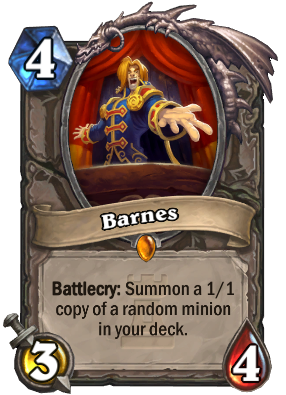
The 4-Mana theatrical impresario is the kind of card players love to hate. Team 5 had experimented with cards that create 1/1 versions of other minions previously with Herald Volazj and Shadowcaster, but because Barnes’ effect doesn’t require anything to be on the board, it could always be activated. The benefits of getting a baby Ragnaros or Savannah Highmane are obvious, but even when Barnes pulled something less spectacular, it was hardly a disaster. Clearly Hearthstone isn’t abandoning high-variance RNG anytime soon.
It also seems true that Team 5 didn’t account for how unhappy people were with the state of the Priest class, or they wouldn’t have printed Purify, the existence of which triggered one of the funnier Hearthstone community outcries we’ve seen in some time. Inevitably the outrage proved a little over the top, as both Priest of the Feast and Onyx Bishop turned out to be perfectly playable.
Thematically speaking, Medivh’s funky disco party was a lot of fun after the Old Gods tentaclefest, although it was a bit odd to have a legendary card for which there was already a hero. As with the other adventures, there were some particularly strong class cards in Karazhan. Moonglade Portal, Malchezaar’s Imp, Cloaked Huntress and Babbling Book have all gone on to become staples in their respective decks.
So why not place Karazhan higher? Well, even if we ignore the fact the PvE encounters felt undercooked and easy, the neutral cards really were thin gruel. Moroes was a wasted legendary, Runic Egg still doesn’t make sense, Pompous Thespian was just boring, and the whole Beast-Dragon-Murloc thing hasn’t really taken off beyond The Curator. It also seems weird that, having nerfed Molten Giant, Team 5 then created Arcane Giant, which could be reduced in cost without any risk by any deck with enough spells.
One card which was a design slam dunk, though, was Prince Malchezaar. Though clearly not intended for serious play outside fringe fatigue decks, it nonetheless gave new players random access to every legendary in the game. A sign that even in somewhat makeweight sets, Team 5 is still capable of pulling interesting concepts out of the ether.
Blackrock Mountain
Here be dragons
Released: April 2015
Another raid-inspired adventure, and with almost half of the cards having some sort of Dragon synergy, another attempt to push a tribe into viability. But while cards like Blackwing Corruptor, Twilight Whelp and Drakonid Crusher were clearly strong, at that stage there weren’t enough good Dragons to create competitive decks. Not that it stopped players from trying, as the scars of frustrated Dragon Paladins show. It was only with The Grand Tournament that Dragon decks really became a thing, with Warrior benefiting most thanks to the survivability of Twilight Guardian and the aggression of Alexstrasza's Champion.
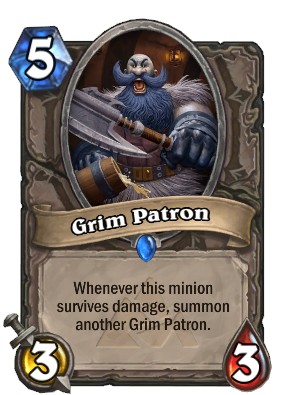
To get a sense of just how ridiculous Patron Warrior deck was at the height of its power, check out this turn from a mirror match at the NA BlizzCon qualifiers in 2015. Despite misplaying, Reynad was able to deal over 70 damage from an empty board. With that kind of combo becoming common at tournaments, Blizzard stepped in to nerf the villain of the piece: Warsong Commander. That didn’t kill Patron Warrior entirely, but with the loss of Death’s Bite thanks to Standard, everyone gets in here a lot less these days.
But back to Blackrock. The failure to make Dragons work at the first attempt hurt the set, but not fatally so. There were some great class cards here. Flamewaker has kept Tempo Mage cooking almost single-handedly ever since, while Imp Gang Boss fits just about any Warlock archetype, and Quick Shot made for some brutal runner-runner finishes in Hunter.
For “Johhny” players, there was also Gang Up, which threatened to make Mill Rogue almost viable, and of course Majordomo Executus, a Legendary with a downside potentially so large that it might be Team 5’s biggest troll card to date. Which of course also made it perfect for streamers who were looking to spice up an eight-hour session. The real power in Blackrock came from two cards, though, both of which were neutral: Grim Patron and Emperor Thaurissan. The latter’s cost-reduction ability looked strong from the start, and fit perfectly into combo decks like Freeze Mage and Midrange Druid. Plenty of players slept on Patron, though.
Before Blackrock, Enrage-based Warrior decks (which benefit from damaging their own dudes) had largely remained niche, relying on Raging Worgens for crazy one-turn kills. But the arrival of Patron, in conjunction with existing cards like Warsong Commander, Frothing Berserker and Death’s Bite, enabled a brand new Warrior deck which was able to “go off” with Inner Rage and Whirlwinds to create deadly board states that were a nightmare to interact with. Pros still talk fondly about the high skill ceiling of Patron Warrior. The rest of just shiver and remember the time when Mathstone was a thing.
Goblins vs Gnomes
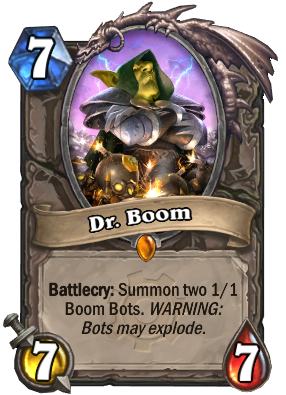
Though Piloted Shredder was arguably more influential, and Unstable Portal even more ridiculous in terms of RNG, it was the good Doctor who became the most iconic card Team 5 had printed since Ragnaros the Firelord. Most pros didn’t see it coming of course, though I do recall an opponent seeing him played against me at the BlizzCon reveal and thinking: “Huh, this thing is a bitch to deal with.” Boom will go down in Hearthstone history as the most powerful auto-include card which somehow never felt the kiss of the nerfbat.
Hello! Hello! Hello!
Released: December 2014
Or to give it its real name: The Mech Set. Or to be even more accurate: Dr Boom, Piloted Shredder and 121 other cards. Goblins vs Gnomes is the best example of Team 5 going all-in on a tribal tag. An incredible 48 cards in the set had some sort of Mech synergy, which brings pluses and minuses. On the upside, it just about guarantees that new archetypes are going to spring up. In this case, neither Mech Shaman or Mage would have existed without GvG. But equally it means that when the set rotates out, an entire tribe will be gutted.
Mech decks were ultimately the least interesting thing about GvG. The real action was in the class cards. Thanks to Coghammer, Shielded Minibot and Muster for Battle, Paladin’s traditionally terrible early game was fixed overnight, and Midrange Pally suddenly became a thing. Priest players also got some rare treats in the form of Lightbomb and Velen’s Chosen, which temporarily nudged the class back into playability, while Warlocks were able to infuriate opponents with high roll Imp-losions and pulling the 9/7 Mal’Ganis out of a Voidcaller’s ass.
But, Boom aside, the star of the show was Piloted Shredder. Even without the Mech tag, Shredder was the ultimate midrange minion: Too threatening to ignore, but hard to remove efficiently. There was barely a deck in the game which didn’t want to slam a Shredder on turn four. The card also shaped a lot of the debate which still rages around RNG, and the level of variance the community considers acceptable. Will it be Doomsayer or Millhouse inside? There was only one way to find out.
Whispers of the Old Gods
In which Yogg became both noun and verb
Released: April 2016
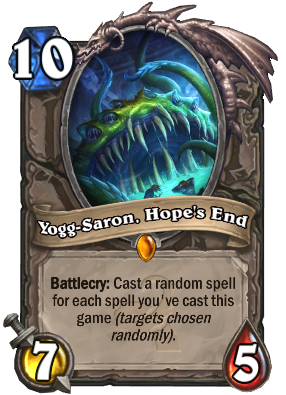
Neither its designers nor the Hearthstone community expected Yogg to be a competitive card, but its dread power soon became apparent as players realised that with enough spells banked, Yogg almost always cleared the board, played some secrets, and drew you a bunch of cards. Infinite YouTube montages followed, and by the time he was getting played in HCT qualifiers, the nerf was inevitable.
Whispers of the Old Gods is the perfect example of Team 5 really committing to the theme of a big set. The theme in this case being: “can you ever really have too many tentacles?” As Naxx proved, and this goes for WoW too, Blizzard’s brand of cartoon fantasy works best when it’s laced with a little bit of menace. In this set, that threat came from the four titular eldritch horrors, each of which cost 10 Mana, had a powerful effect, and owned more eyeballs than could be considered strictly necessary.
Old Gods success rested entirely on whether or not these expensive cards would see play. Expensive “big boy” cards had been ruthlessly preyed upon by Big Game Hunter, so to give their new monstrosities the best chance Team 5 nerfed the dwarf sharpshooter just before the set hit, and also gifted C’Thun and a couple of his buff cards to every player. The old gods’ unique abilities meant that they were bound to at least be experimented with—in Yogg’s case, little did we suspect how much—and ultimately all four horrors found decks to call home, with even Y’Shaarj making his way into Ramp Druid.
Aside from its flashy build-around legendaries, one of the things to like most about Old Gods is how consistently it shared the love. Druid got Fandral, Hunter got Call of the Wild, Warrior got Ravaging Ghoul, Paladin got the new Rag, and Priest… well, Priest got the shaft again, but by then they were used to it. The real winner, of course, was Shaman, which added Flamewreathed Faceless and Thing From Below to its already disgusting roster of brutally-statted minions. A 4 Mana 7/7 inevitably overshadowed more fun cards like Evolve, and these days Shaman decks are so efficient they often don’t even bother running the 7/7! It had taken Team 5 three sets to do it, but Shaman was finally top tier. There’s hope for Priest yet.
The League of Explorers
Do you take Discover card here?
Released: November 2015
Despite not quite taking top spot, The League of Explorers is the most confident expansion Team 5 has designed so far. The decision to depart from WoW lore and create their own characters can’t have been taken lightly, but it completely worked. As a set, League is defined by its brilliant legendaries. Dapper Murloc Sir Finley Mrrgglton reinvigorated aggressive strategies by enabling classes to swap hero powers, Brann made for spectacular value plays in decks with plenty of Battlecry effects, and Elise opened up new, even more grindy, horizons for control aficionados.
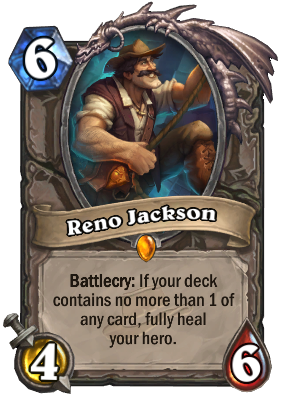
There may be no single more satisfying moment in Hearthstone than healing from 1 HP with Reno to crush the dreams of some despicable Face Shaman player. (Though I did list some other possibilities here.) Credit also to artist Tyson Murphy for giving Reno exactly the sort of shit-eating grin that you have on your own face whenever he wins you the game.
But it was Reno and his giant heal that players instantly fell in love with. Except for Hunter mains, who of course hated him. Reno, like Emperor Thaurissan before him, is the kind of card that refreshes Hearthstone and sells expansions single-handed.
It’s also worth noting that each of the four explorers asked you to consider building your deck slightly differently to get the most from their effect, with Reno being the most extreme example. This focus on powerful build-around cards is something Team 5 would return to in even greater force with the next full set, Whisper of the Old Gods, and can also be seen in the recent push to make legendary cards that are situationally strong, rather than equally playable in any context. Dr Boom’s time has passed.
Arguably the real hero of League is the Discover mechanic. After the whiff of The Grand Tournament’s Inspire keyword, Team 5 needed a hit, and Discover was it. Cards like Raven Idol, Dark Peddler and Ethereal Conjurer showed that when card draw RNG is limited to a restricted pool, it makes for an interesting and satisfying effect. (Or at least that’s how I justify playing four copies of Power Overwhelming in the same game.) Hearthstone is best when it involves lots of small decisions, rather than just coughing up creatures on curve. Though let’s counterbalance all this love for League by saying it’s also the set that gave the world Tunnel Trogg, which finally pushed the Shaman class over the top.
Curse of Naxxramas
Death is not the end
Released: July 2014
It’s testament to the fondness the Hearthstone community has for the game’s first expansion that “Naxx out?” still gets spammed fairly often in Twitch chat. Of course, there’s a danger of overrating the set based purely on nostalgia. We were so thirsty for new cards by the time Naxx arrived, and it was Blizzard’s first attempt at PvE “adventure” content, that its impact was always going to be explosive. But the real reason Naxx was so great is that Team 5 didn’t really know what it was doing.
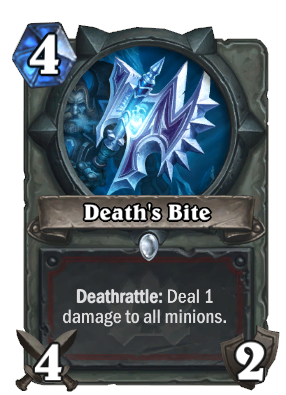
Undertaker was too unhealthy to celebrate here, but you can take your pick from any one of the ubiquitous Deathrattle cards. I’ve gone for Death’s Bite simply because it came to define the Warrior class. For as long as it was available, this weapon was an absolute terror, and for a time all but made Azure Drake unplayable.
How could they? Back then the designers had to guess at how powerful their creations would prove once players got their hands on them. And in Naxx’s case, the answer was: insanely so. Revisit Naxx in your collection and it’s a startling powerhouse. The hit factory includes staples like Mad Scientist, Voidcaller, Sludge Belcher and the absolutely degenerate Undertaker, which pushed the set’s Deathrattle theme into the stratosphere. These cards are so good that there’s a strong case for saying that Naxx is the biggest reason why Blizzard had to introduce the Standard format. Without it, we’d have been playing Nerubian Eggs forever.
Naxx isn’t just great because it’s cards are OP, though. The use of a classic WoW raid for the setting was inspired, and the creepy haunted house vibe fit the Deathrattle theme like a beautiful but mouldy glove. In the Classic set the Deathrattle keyword had only seen limited use, so Team 5 had plenty of its beloved design space to explore. But what they underrated was how powerful an effect minion “stickiness” was, with even seemingly innocuous cards like Haunted Creeper turning out to be a huge pain to deal with cleanly.
Naxx also featured some of Hearthstone’s most elegantly-designed tech cards. Deathlord countered aggro, but came with a considerable trade-off, while the mighty Loatheb’s anti-spell effect provided an answer to Miracle Rogue that was far more interesting than any nerf would have been. In terms of sheer bang for the player’s buck, Naxx was absolutely essential and comfortably the best Hearthstone set. We will not see its like again.
With over two decades covering videogames, Tim has been there from the beginning. In his case, that meant playing Elite in 'co-op' on a BBC Micro (one player uses the movement keys, the other shoots) until his parents finally caved and bought an Amstrad CPC 6128. These days, when not steering the good ship PC Gamer, Tim spends his time complaining that all Priest mains in Hearthstone are degenerates and raiding in Destiny 2. He's almost certainly doing one of these right now.
